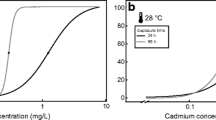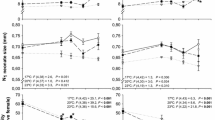Abstract
The Intergovernmental Panel on Climate Change projects that global climate change will have significant impacts on environmental conditions including potential effects on sensitivity of organisms to environmental contaminants. The objective of this study was to test the climate-induced toxicant sensitivity (CITS) hypothesis in which acclimation to altered climate parameters increases toxicant sensitivity. Adult Physa pomilia snails were acclimated to a near optimal 22 °C or a high-normal 28 °C for 28 days. After 28 days, snails from each temperature group were challenged with either low (150 μg/L) or high (300 μg/L) cadmium at each temperature (28 or 22 °C). In contrast to the CITS hypothesis, we found that acclimation temperature did not have a strong influence on cadmium sensitivity except at the high cadmium test concentration where snails acclimated to 28 °C were more cadmium tolerant. However, snails that experienced a switch in temperature for the cadmium challenge, regardless of the switch direction, were the most sensitive to cadmium. Within the snails that were switched between temperatures, snails acclimated at 28 °C and then exposed to high cadmium at 22 °C exhibited significantly greater mortality than those snails acclimated to 22 °C and then exposed to cadmium at 28 °C. Our results point to the importance of temperature variability in increasing toxicant sensitivity but also suggest a potentially complex cost of temperature acclimation. Broadly, the type of temporal stressor exposures we simulated may reduce overall plasticity in responses to stress ultimately rendering populations more vulnerable to adverse effects.


Similar content being viewed by others
References
Adeyeme JA, Klerks PL (2012) Salinity acclimaiton modulates copper toxicity in the shepshead minnow Cyprinodon variegatus. Environ Toxicol Chem 31:1573–1579
Anderson JT, Smith LM (2000) Invertebrate response to moist-soil management of playa wetlands. Ecol Appl 10:550–558
Becker CD, Genoway RG (1979) Evaluation f the critical thermal maximum for determining thermal tolerance of freshwater fish. Environ biol fish 4:245–256
Bodar CM, van der Sluis I, van Montfort JP, Voogt PA, Zandee DI (1990) Cadmnium resisitance in Daphnia magna. Aquat Toxicol 16:33–40
Bossuyt BA, Janssen CR (2003) Acclimation of Daphnia magna to environmentally realistic copper concetrations. Comp Biochem physiol Part C 136:253–264
Brett JR (1952) Temperature tolerance in young Pacific Salmon, Genus Oncorhynchus. J Fish Res Board Can 9:265–323
Calow P, Forbes V (1998) How do physiological responses to stress translate into ecological and evolutionary processes? Comp Biochem Physiol Mol Integr Physiol 120:11–16
Cherkasova AS, Ringwood AH, Sokolova IM (2006) Combined effects of temperature acclimation and cadmium exposure on mitochondrial function in eastern oyster Crassostrea virginica Gmelin (Bivalvia: Osteridae). Environ Toxicol Chem 25:2461–2569
Coors A, De Meester L (2008) Synergistic, antagonistic and additive effects of multiple stressors: predation threat, parasitism and pesticide exposure in Daphnia magna. J Appl Ecol 45:1820–1828
De Block M, Stoks R (2005) Fitness effects from egg to reproduction: bridging the life history transition. Ecology 86:185–197
Environmental Integrity Project and Earthjustice (2010) Out of control: mounting damages from coal ash waste sites. Washington, DC
Feldmeth C, Stone E, Brown J (1974) An increased scope for thermal toelrance upon acclimating Pupfish (Cyprinodon) to cycling temperatures. J Comp Physiol 89:38–44
Fischer BB, Pomati F, Eggen RIL (2013) The toxicity of chemical pollutants in dynamic natural systems: the challenge of integrating environmental factors and biological complexity. Sci Total Environ 449:253–259
Gordon CJ (2003) Role of environmental stress in the physiological response to chemical toxicants. Environ Res 92:1–7
Gouin T, Armitage J, Cousins I et al (2013) Influence of global climate change on chemical fate and bioaccumulation: the role of multimedia models. Environ Toxicol Chem 32:20–31
Heugens EHW, Hendriks AJ, Dekker T et al (2001) A review of the effects of multiple stressors on aquatic organisms and analysis of uncertainty factors for use in risk assessment. CRC Crit Rev Toxicol 31:247–284
Heugens EHW, Jager T, Creyghton R et al (2003) Temperature-dependent effects of cadmium on Daphnia magna: accumulation versus sensitivity. Environ Sci Technol 37:2145–2151
Holmstrup M, Bindesbøl AM, Oostingh GJ et al (2010) Interactions between effects of environmental chemicals and natural stressors: a review. Sci Total Environ 408:3746–3762
Hooper M, Ankley G, Cristol D et al (2013) Interactions between chemical and climate stressors: a role for mechanistic toxicology in assessing climate change risks. Environ Toxicol Chem 32:32–48
Hutchison VH, Maness JD (1979) The role of behavior in temperature acclimation and tolerance in ectotherms. Amer. Zool 19:367–384
IPCC (2007) Climate change 2007: The scientific basis. In: Solomon S, Qin D, Manning M, Chen Z, Marquis M, Averyt KB, Tignor M, Miller HL (eds) Contributions of working group I to the fourth assessment report of the Intergovernmental Panel on climate change: “The Physical Science Basis”. Cambridge University Press, Cambridge, pp 1–18
Kimberly D, Salice C (2012) Dietary acclimation affects dietary selection in the freshwater snail Planorbella trivolvis. J Molluscan Stud 78:256–261
Kimberly D, Salice C (2013) If you could turn back time: understanding transgenerational latent effects of developmental exposure to contaminants. Environmental Polliution; in press
Kimberly DA, Salice CJ (2014) If you could turn back time: understanding transgenerational latent effects of developmental exposure to contaminants. Environ Pollut 184:419–425
Kishida O, Trussell GC, Mougi A et al (2010) Evolutionary ecology of inducible morphological plasticity in predator–prey interaction: toward the practical links with population ecology. Popul Ecol 52:37–46
Kita JS, Tsuchida S, Setoguma T (1996) Temperature preferences and tolerance, and oxygen consumption of the marbled rockfish, Sebastiscus marmoratus. J Fish Aquat Sci 125:467–471
Lannig G, Flores J, Sokolova I (2006) Temperature-dependent stress response in oysters, Crassostrea virginica: pollution reduces temperature tolerance in oysters. Aquat Toxicol 79:278–287
Lannig G, Cherkasov A, Portner H, Bock C, Sokolova I (2008) Cadmium-dependent oxygen limitation affects temperature tolerance in eastern oysters (Crassostrea virginica Gmelin). Am J Physiol Regul Integr Comp Physiol 294:1338–1346
LeBlanc GA (1982) Laboratory investigations into the development of resistance of Daphnia magna (Straus) to environmental pollutants. Environ. Pollut. (Series A) 27:309–322
Meyer JN, Di Giulio RT (2003) Heritable adaptation and fitness costs in killifish (Fundulus heteroclitus) inhabiting a polluted estuary. Ecologicla Applica 13:490–503
Moe S, De Schamphelaere K, Clements W, Sorensen M, Van den Brink P, Liess M (2013) Combined and interactive effects of global climate change and toxicants on populations and communities. Environ Toxicol Chem 32:49–61
Muyssen BA, Janssen CR (2001) Multi-generation zinc acclimation and tolerance in Daphnia magna: implications for water quality guidelines and ecological risk assessment. Environ Toxicol Chem 20:2053–2060
Newman MC, Aplin MS (1992) Enhancing toxicity data interpretation and prediction of ecological risk with survival time modeling: an illustration using sodium chloride toxicity to mosquitofish (Gambusia holbrooki). Aquat Toxicol 23:85–96
Noyes PD, McElwee MK, Miller HD, Clark BW, Van Tiem LA, Walcott KC, Erwin KN, Levin ED (2009) The toxicology of climate change: environmental contaminants in a warming world. Environ Int 35:971–986
Parmesan C (2006) Ecological and evolutionary responses to recent climate change. Annu Rev Ecol Evol Syst 37:637–669
Pörtner HO (2002) Climate variations and the physiological basis of temperature dependent biogeography: systemic to molecular hierarchy of thermal tolerance in animals. Comp Biochem Physiol A: Mol Integr Physiol 132:739–761
Postma J, Vankleunen A, Admiraal W (1995) Alterations in life-history traits of chironomus-riparius (diptera) obtained from metal-contaminated rivers. Arch Environ Contam Toxicol 29:469–475
Ricciardi A, Rasmussen J (1990) Extinction rates of North American freshwater fauna. Conserv Biol 13:1220–1222
Roff DA (2002) Life history evolution; Sinauer, Sunderland
Salice CJ, Kimberly DA (2013) Envionrmentally relevant concentrations of a common insecticide increase predation risk in a freshwater gastropod 22:42–49
Salice CJ, Anderson T, Roesijadi G (2010) Adaptive responses and latent costs of multigeneration cadmium exposure in parasite resistant and susceptible strains of a freshwater snail. Ecotoxicology 19:1466–1475
Seeland A, Albrand J, Oehlmann J, Müller R (2013) Life stage-specific effects of the fungicide pyrimethanil and temperature on the snail Physella acuta (Draparnaud, 1805) disclose the pitfalls for the aquatic risk assessment under global climate change. Environ Pollut 174:1–9
Schiedek D, Sundelin B, Readman JW, Macdonald RW (2007) Interactions between climate change and contaminants. Mar Pollut Bull 54:1845–1856
Sokolova IM (2013) Energy-limited tolerance to stress as a conceptual framework to integrate the effects of mulitple stressors. Integr Comp Biol 53:597–608
Sokolova IM, Lannig G (2008) Interactive effects of metal pollution and temperature on metabolism in aquatic ectotherms: implications of global climate change. Clim Res 37:181–201
Stahl RG, Hooper MJ, Balbus JM, Clements W, Fritz A, Gouin T, Helm R, Hickey C, Landis W, Moe SJ (2013) The influence of global climate change on the scientific foundations and applications of environmental toxicology and chemistry: introduction to a SETAC international workshop. Environ Toxicol Chem 32:13–19
Stuhlbacher A, Bradley MC, Naylor C, Calow P (1992) Induction of cadmium tolerance in two clones of Daphnia magna Straus. Comp Biochem Physiol C 101:571–577
Sublette JE, Sublette MS (1967) The limnology of playa lakes on the Llano Estacado, New Mexico and Texas. Southwest Nat 12:369–406
Tagatz ME (1969) Some relations of temperature acclimation and salinity to thermal tolerance of the blue crab, Callinectus sapidus. Trans Amer Fish Soc 98:713–716
R development core team (2010) R: a language and environment for statistical computing. R foundation for statistical computig; Vienna, Austria
Van der Schalie H, Berry HE (1971) Effects of temperature on groth and reproduction in aquatic snails. US Environemntal Protectoin Agency; Washington, DC
Van KD, Janssens L, Debecker S, De Jonge M, Lambert P, Nilsson-Örtman V, Bervoets L, Stoks R (2013) Susceptibility to a metal under global change warming is shaped by thermal adaptation along a latitudinal gradient. Glob Change Biol. doi:10.1111/gcb.12243
Venables WN, Ripley BD (2002) Modern applied statistics with S; Springer, New York
Ward T, Robinson W (2005) Evolution of cadmium resistance in Daphnia magna. Environ Toxicol Chem 24:2341–2349
Wethington AR, Lydeard C (2007) A molecular phylogeny of Physidae (Gastropoda: basommatophora) based on mitochondrial DNA sequences. J Molluscan Stud 73:241–257
World Bank Group (1999) Polution prevetnion and abatement handbook; Washington, DC
Xie L, Klerks P (2004) Fitness cost of resistance to cadmium in the least killifish (Heterandria formosa). Environ Toxicol Chem 23:1499–1503
Zuur A, Leno EN, Walker N, Saveliev AA, Smith GM (2009) Mixed effects models and extensions in ecology with R. Springer
Acknowledgments
DAK would like to thank Texas Tech University, The Institute of Environmental and Human Health (TIEHH) and the Conchologists of America for funding. This manuscript was improved with helpful comments from two anonymous reviewers.
Conflict of interest
The authors declare that they have no conflict of interest.
Author information
Authors and Affiliations
Corresponding author
Rights and permissions
About this article
Cite this article
Kimberly, D.A., Salice, C.J. Complex interactions between climate change and toxicants: evidence that temperature variability increases sensitivity to cadmium. Ecotoxicology 23, 809–817 (2014). https://doi.org/10.1007/s10646-014-1221-y
Accepted:
Published:
Issue Date:
DOI: https://doi.org/10.1007/s10646-014-1221-y




